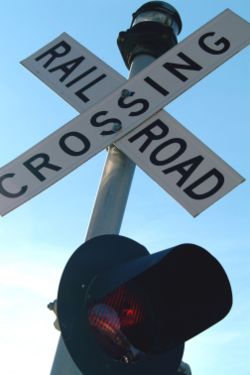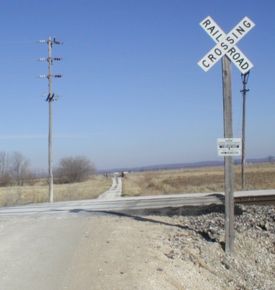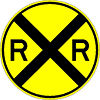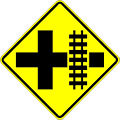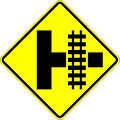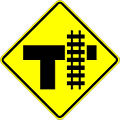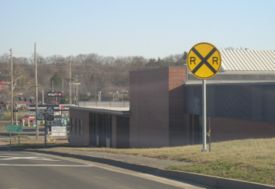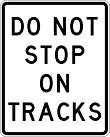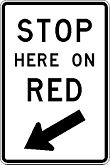903.19 Signing for Rail and Light Rail Transit Grade Crossings
Contents
- 1 903.19.1 Signs Purpose (MUTCD Section 8B.01)
- 2 903.19.2 Sizes of Grade Crossing Signs (MUTCD Section 8B.02)
- 3 903.19.3 Grade Crossing (Crossbuck) Sign (R15-1) and Number of Tracks Plaque (R15-2P) at Active and Passive Grade Crossings (MUTCD Section 8B.03)
- 4 903.19.4 Crossbuck Assemblies with YIELD or STOP Signs at Grade Crossings (MUTCD Section 8B.04)
- 5 903.19.5 Use of STOP (R1-1) or YIELD (R1-2) Signs without Crossbuck Signs at Highway-LRT Grade Crossings (MUTCD Section 8B.05)
- 6 903.19.6 Grade Crossing Advance Warning Signs (W10 Series) (MUTCD Section 8B.06)
- 7 903.19.7 EXEMPT Highway-Rail Grade Crossing Plaques (R15-3P, W10-1aP) (MUTCD Section 8B.07)
- 8 903.19.8 Turn Restrictions During Preemption (MUTCD Section 8B.08)
- 9 903.19.9 DO NOT STOP ON TRACKS Sign (R8-8) (MUTCD Section 8B.09)
- 10 903.19.10 STOP HERE ON RED Sign (R10-6) (MUTCD Section 8B.12)
903.19.1 Signs Purpose (MUTCD Section 8B.01)
Support. Whenever the acronym LRT is used in EPG 903.20, it refers to light rail transit.
Passive traffic control systems, consisting of signs and pavement markings only, identify and direct attention to the location of a grade crossing and advise road users to slow down or stop at the grade crossing as necessary in order to yield to any rail traffic occupying, or approaching and in proximity to, the grade crossing.
Signs and markings regulate, warn, and guide the road users so that they, as well as LRT vehicle operators on mixed-use alignments, can take appropriate action when approaching a grade crossing.
Standard. The design and location of signs shall comply with the provisions of the EPG. The design and location of pavement markings shall comply with the provisions of EPG 620 Pavement Marking.
903.19.2 Sizes of Grade Crossing Signs (MUTCD Section 8B.02)
Standard. The sizes of grade crossing signs shall be as shown in Table 903.19.2.
Option. Signs larger than those shown in Table 903.19.2 may be used (refer to EPG 903.2.21 Dimensions).
Table 903.19.2 Grade Crossing Sign and Plaque Sizes
| Sign or Plaque | Sign Designation | EPG Article | Conventional Road (in.) | Freeway/Expressway (in.) | ||
|---|---|---|---|---|---|---|
| Single Lane | Multi-Lane | Oversized | Mainline and Ramps | |||
| Railroad Crossing | W10-1 | 903.19.6 | 42 dia. | 42 dia. | - | 48 dia. |
| Crossroad Railroad Crossing | W10-2 | 903.19.6 | 36 X 36 | 36 X 36 | - | 48 X 48 |
| Side Road Railroad Crossing | W10-3 | 903.19.6 | 36 X 36 | 36 X 36 | - | 48 X 48 |
| T-Intersection Railroad Crossing | W10-4 | 903.19.6 | 36 X 36 | 36 X 36 | - | 48 X 48 |
| EXEMPT | R15-3P | 903.19.7 | 24 x 12 | 24 X 12 | - | - |
| EXEMPT | W10-1aP | 903.19.7 | 24 x 12 | 24 X 12 | - | - |
| DO NOT STOP ON TRACKS | R8-8 | 903.19.9 | 24 X 30 | 24 X 30 | - | 36 X 48 |
| STOP HERE ON RED | R10-6 | 903.19.10 | 24 x 36 | 24 x 36 | - | - |
903.19.3 Grade Crossing (Crossbuck) Sign (R15-1) and Number of Tracks Plaque (R15-2P) at Active and Passive Grade Crossings (MUTCD Section 8B.03)
Support. The Grade Crossing (R15-1) sign, commonly identified as the Crossbuck sign and Number of Tracks (R15-2P) plaque are provided by the appropriate railroad company. Railroads are responsible for the installation and maintenance of these signs.
Standard. The Grade Crossing (R15-1) sign shall be retroreflectorized white with the words RAILROAD CROSSING in black lettering, mounted as shown in Fig. 903.19.3.
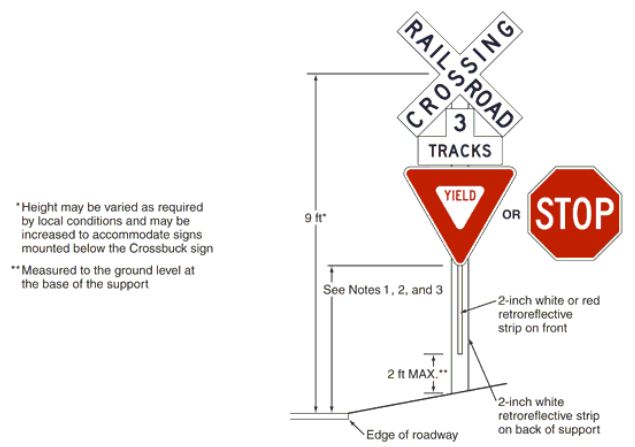
| Notes: |
| 1. YIELD or STOP signs are used only at passive crossings. A STOP sign is used only if an engineering study determines that it is appropriate for that particular approach. |
| 2. Mounting height shall be at least 5 ft. for installations of YIELD or STOP signs on existing Crossbuck sign supports. |
| 3. Mounting height shall be at least 7 ft. for new installations in areas with pedestrian movements or parking. |
Support. In most states, the Crossbuck sign requires road users to yield the right of way to rail traffic at a grade crossing.
Standard. As a minimum, one Crossbuck sign shall be used on each highway approach to every highway-rail grade crossing, alone or in combination with other traffic control devices.
Option. A Crossbuck sign may be used on a highway approach to a highway-LRT grade crossing on a semi-exclusive or mixed-use alignment, alone or in combination with other traffic control devices.
Standard. If automatic gates are not present and if there are two or more tracks at a grade crossing, the number of tracks shall be indicated on a supplemental Number of Tracks (R15-2P) plaque of inverted T shape mounted below the Crossbuck sign in the manner shown in Fig. 903.19.3.
On each approach to a highway-rail grade crossing and, if used, on each approach to a highway-LRT grade crossing, the Crossbuck sign shall be installed on the right-hand side of the highway on each approach to the grade crossing. Where restricted sight distance or unfavorable highway geometry exists on an approach to a grade crossing, an additional Crossbuck sign shall be installed on the left-hand side of the highway, possibly placed back-to-back with the Crossbuck sign for the opposite approach, or otherwise located so that two Crossbuck signs are displayed for that approach.
A strip of retroreflective white material not narrower than 2 inches shall be used on the back of each blade of each Crossbuck sign for the length of each blade, at all grade crossings where Crossbuck signs have been installed, except those where Crossbuck signs have been installed back-to-back.
Guidance. Crossbuck signs should be located with respect to the highway pavement or shoulder in accordance with the criteria in EPG 903.2.26, and should be located with respect to the nearest track.
The minimum lateral offset for the nearest edge of the Crossbuck sign should be 6 ft. from the edge of the shoulder or 12 ft. from the edge of the traveled way in rural areas (whichever is greater), and 2 ft. from the face of the curb in urban areas.
Where unusual conditions make variations in location and lateral offset appropriate, engineering judgment should be used to provide the best practical combination of view and safety clearances.
903.19.4 Crossbuck Assemblies with YIELD or STOP Signs at Grade Crossings (MUTCD Section 8B.04)
Support. MoDOT’s Multimodal Operations Division developed a Stop Sign Fact Sheet to help determine if a Stop sign should be displayed below the Crossbuck sign instead of a Yield sign a passive railroad crossings.
Standard. A grade crossing Crossbuck Assembly shall consist of a Crossbuck (R15-1) sign and a Number of Tracks (R15-2P) plaque if two or more tracks are present, and either a YIELD (R1-2) or STOP (R1-1) sign installed on the same support except as provided in the option below. If used at a passive grade crossing, a YIELD or STOP sign shall be installed.
At all public highway-rail grade crossings that are not equipped with the active traffic control systems, except crossings where road users are directed by an authorized person on the ground to not enter the crossing at all times that an approaching train is about to occupy the crossing, a Crossbuck Assembly shall be installed on the right-hand side of the highway on each approach to the highway-rail grade crossing.
If a Crossbuck sign is used on a highway approach to a public highway-LRT grade crossing that is not equipped with the active traffic control systems, a Crossbuck Assembly shall be installed on the right-hand side of the highway on each approach to the highway-LRT grade crossing.
Where restricted sight distance or unfavorable highway geometry exists on an approach to a grade crossing that has a Crossbuck Assembly, or where there is a one-way multi-lane approach, an additional Crossbuck Assembly shall be installed on the left-hand side of the highway.
A YIELD sign shall be the default traffic control device for Crossbuck Assemblies on all highway approaches to passive grade crossings unless an engineering study performed by the regulatory agency or highway authority having jurisdiction over the roadway approach determines that a STOP sign is appropriate.
Support. MoDOT’s Multimodal Operations Division developed a Stop Sign Fact Sheet to help determine whether a STOP sign should be displayed below the Crossbuck sign instead of a YIELD sign a passive railroad crossings.
Guidance. The use of STOP signs at passive grade crossings should be limited to unusual conditions where requiring all highway vehicles to make a full stop is deemed essential by an engineering study. Among the factors that should be considered in the engineering study are the line of sight to approaching rail traffic (giving due consideration to seasonal crops or vegetation beyond both the highway and railroad or LRT rights of way), the number of tracks, the speeds of trains or LRT equipment and highway vehicles, and the crash history at the grade crossing.
Option. If a YIELD or STOP sign is installed for a Crossbuck Assembly at a grade crossing, it may be installed on the same support as the Crossbuck sign or it may be installed on a separate support at a point where the highway vehicle is to stop, or as near to that point as practical, but in either case, the YIELD or STOP sign is considered to be a part of the Crossbuck Assembly, see Figs. 903.19.4.1 and 903.19.4.2.

| Notes: |
| 1. YIELD signs are used only at passive crossings. |
| 2. Place the face of the signs in the same plane and place the YIELD sign closest to the traveled way. Provide a 2 in. minimum separation between the edge of the Crossbuck sign and the edge of the YIELD sign. |
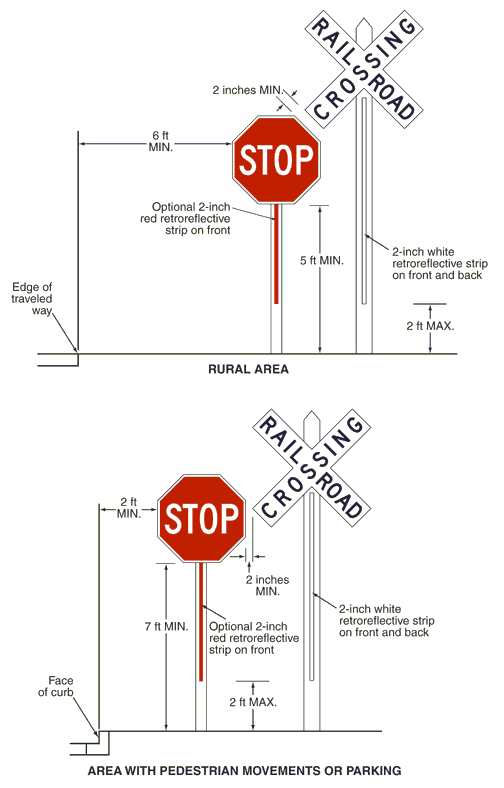
| Notes: |
| 1. STOP signs are used only at passive crossings and only if an engineering study determines that it is appropriate for that particular approach. |
| 2. Place the face of the signs in the same plane and place the STOP sign closest to the traveled way. Provide a 2 in. minimum separation between the edge of the Crossbuck sign and the edge of the STOP sign. |
Standard. If a YIELD or STOP sign is installed on an existing Crossbuck sign support, the minimum height, measured vertically from the bottom of the YIELD or STOP sign to the top of the curb, or in the absence of curb, measured vertically from the bottom of the YIELD or STOP sign to the elevation of the near edge of the traveled way, shall be 5 feet.
If a Crossbuck Assembly is installed on a new sign support or if the YIELD or STOP sign is installed on a separate support, the minimum height, measured vertically from the bottom of the YIELD or STOP sign to the top of the curb, or in the absence of curb, measured vertically from the bottom of the YIELD or STOP sign to the elevation of the near edge of the traveled way, shall be 7 ft. if the Crossbuck Assembly is installed in an area where parking or pedestrian movements are likely to occur.
Guidance. If a YIELD or STOP sign is installed for a Crossbuck Assembly at a grade crossing on a separate support than the Crossbuck sign, the YIELD or STOP sign should be placed at a point where the highway vehicle is to stop, or as near to that point as practical, but no closer than 15 ft. measured perpendicular from the nearest rail.
Support. The meaning of a Crossbuck Assembly that includes a YIELD sign is that a road user approaching the grade crossing needs to be prepared to decelerate, and when necessary, yield the right of way to any rail traffic that might be occupying the crossing or might be approaching and in such close proximity to the crossing that it would be unsafe for the road user to cross.
Certain commercial motor vehicles and school buses are required to stop at all grade crossings in accordance with 49 CFR 392.10 even if a YIELD sign (or just a Crossbuck sign) is posted.
The meaning of a Crossbuck Assembly that includes a STOP sign is that a road user approaching the grade crossing must come to a full and complete stop not less than 15 ft. short of the nearest rail, and remain stopped while the road user determines if there is rail traffic either occupying the crossing or approaching and in such close proximity to the crossing that the road user must yield the right of way to rail traffic. The road user is permitted to proceed when it is safe to cross.
Standard. A vertical strip of retroreflective white material, not narrower than 2 inches, shall be used on each Crossbuck support at passive grade crossings for the full length of the back of the support from the Crossbuck sign or Number of Tracks plaque to within 2 feet above the ground, except as provided in the option below.
Option. The vertical strip of retroreflective material may be omitted from the back sides of Crossbuck sign supports installed on one-way streets.
If a YIELD or STOP sign is installed on the same support as the Crossbuck sign, a vertical strip of red or white retroreflective material that is at least 2 inches wide may be used on the front of the support from the YIELD or STOP sign to within 2 ft. above the ground.
Standard. If a Crossbuck sign support at a passive grade crossing does not include a YIELD or STOP sign (either because the YIELD or STOP sign is placed on a separate support or because a YIELD or STOP sign is not present on the approach), a vertical strip of retroreflective white material, not narrower than 2 inches, shall be used for the full length of the front of the support from the Crossbuck sign or Number of Tracks plaque to within 2 ft. above the ground.
At all grade crossings where YIELD or STOP signs are installed, Yield Ahead (W3-2) or Stop Ahead (W3-1) signs shall also be installed if the criteria for their installation is met.
903.19.5 Use of STOP (R1-1) or YIELD (R1-2) Signs without Crossbuck Signs at Highway-LRT Grade Crossings (MUTCD Section 8B.05)
Standard. For all highway-LRT grade crossings where only STOP (R1-1) or YIELD (R1-2) signs are installed, the placement shall comply with the requirements of EPG 903.5.4.2 and EPG 903.5.5.2. Stop Ahead (W3-1) or Yield Ahead (W3-2) Advance Warning signs shall also be installed if the criteria for their installation is met.
Guidance. The use of only STOP or YIELD signs for road users at highway-LRT grade crossings should be limited to those crossings where the need and feasibility is established by an engineering study. Such crossings should have all of the following characteristics:
- A. The crossing roadways should be secondary in character (such as a minor street with one lane in each direction, an alley, or a driveway) with low traffic volumes and low speed limits. The specific thresholds of traffic volumes and speed limits should be determined by the local agencies.
- B. LRT speeds do not exceed 25 mph.
- C. The line of sight for an approaching LRT operator is adequate from a sufficient distance such that the operator can sound an audible signal and bring the LRT equipment to a stop before arriving at the crossing.
- D. The road user has sufficient sight distance at the stop line to permit the vehicle to cross the tracks before the arrival of the LRT equipment.
- E. If at an intersection of two roadways, the intersection does not meet the warrants for a traffic control signal.
- F. The LRT tracks are located such that highway vehicles are not likely to stop on the tracks while waiting to enter a cross street or highway.
903.19.6 Grade Crossing Advance Warning Signs (W10 Series) (MUTCD Section 8B.06)
Standard. A Highway-Rail Grade Crossing Advance Warning (W10-1) sign shall be used on each highway in advance of every highway-rail grade crossing, and every highway-LRT grade crossing in semi-exclusive alignments.
The placement of the Grade Crossing Advance Warning sign shall be in accordance with EPG 903.6.6 and Table 903.6.6.
A Yield Ahead (W3-2) or Stop Ahead (W3-1) Advance Warning sign shall also be installed if the criteria for their installation are met. If a Yield Ahead or Stop Ahead sign is installed on the approach to the crossing, the W10-1 sign shall be installed upstream from the Yield Ahead or Stop Ahead sign. The Yield Ahead or Stop Ahead sign shall be located in accordance with Table 903.6.6. The minimum distance between the signs shall be in accordance with EPG 903.6.6 and Table 903.6.6.
Option. On divided highways and one-way streets, an additional W10-1 sign may be installed on the left-hand side of the roadway.
The Crossroad Railroad Crossing (W10-2), Side Road Railroad Crossing (W10-3), and T-Intersection Railroad Crossing (W10-4) signs may be installed on highways that are parallel to the railroads. The purpose of these signs is to warn a motorist making a turn from the state system onto another roadway system that a railroad crossing is ahead. On divided highways it is desirable to erect an additional warning sign on the left side of the approaching roadway.
Standard. If the distance between the tracks and a parallel highway, from the edge of the tracks to the edge of the parallel roadway, is less than 100 ft., W10-2, W10-3, or W10-4 signs shall be installed on each approach of the parallel highway to warn travelers making a turn that they will encounter a grade crossing soon after making a turn and a W10-1 sign for the approach to the tracks shall not be required to be between the tracks and the parallel highway.
If the W10-2, W10-3, or W10-4 signs are used, sign placement in accordance with the guidelines for Intersection Warning signs in Table 903.6.6 using the speed of through traffic shall be measured from the highway intersection.
Guidance. If the distance between the tracks and the parallel highway, from the edge of the tracks to the edge of the parallel roadway, is 100 ft. or more, a W10-1 sign should be installed in advance of the grade crossing and the W10-2, W10-3, or W10-4 signs should not be used on the parallel highway.
903.19.7 EXEMPT Highway-Rail Grade Crossing Plaques (R15-3P, W10-1aP) (MUTCD Section 8B.07)
Option. When authorized by MoDOT’s Multimodal Operations Division, a supplemental EXEMPT (R15-3P) plaque with a white background may be used below the Crossbuck sign or Number of Tracks plaque, if present, at the grade crossing.
When authorized by MoDOT’s Multimodal Operations Division, a supplemental EXEMPT (W10-1aP) plaque with a fluorescent yellow background may be used below the Grade Crossing Advance Warning (W10 series) sign.
Where neither the Crossbuck sign nor the advance warning signs exist for a particular highway-LRT grade crossing, an EXEMPT (R15-3P) plaque with a white background may be placed on its own post on the near right-hand side of the approach to the crossing.
Support. These supplemental plaques inform drivers of highway vehicles carrying passengers for hire, school buses carrying students or highway vehicles carrying hazardous materials that a stop is not required at certain designated l grade crossings, except when a train, locomotive or other railroad equipment is approaching or occupying the highway-rail grade crossing, or the driver's view is blocked.
903.19.8 Turn Restrictions During Preemption (MUTCD Section 8B.08)
Guidance. At a signalized intersection that is located within 200 ft. of a highway-rail grade crossing, measured from the edge of the track to the edge of the roadway, where the intersection traffic control signals are preempted by the approach of a train, all existing turning movements toward the highway-rail grade crossing should be prohibited during the signal preemption sequences.
Option. A blank-out or changeable message sign and/or appropriate highway traffic signal indication or other similar type sign may be used with the approval of Central Office Highway Safety and Traffic Division to prohibit turning movements toward the highway-rail grade crossing during preemption.
Support. LRT operations can include the use of activated blank-out sign technology for turn prohibition signs. The signs are typically used on roads paralleling a semi-exclusive or mixed-use LRT alignment where road users might turn across the LRT tracks. A blank-out sign displays its message only when activated. When not activated, the sign face is blank.
Guidance. An LRT-activated blank-out turn prohibition sign should be used where an intersection adjacent to a highway-LRT crossing is controlled by STOP signs, or is controlled by traffic control signals with permissive turn movements for road users crossing the tracks.
Option. An LRT-activated blank-out turn prohibition sign may be used for turning movements that cross the tracks.
As an alternative to LRT-activated blank-out turn prohibition signs at intersections with traffic control signals, exclusive traffic control signal phases such that all movements that cross the tracks have a steady red indication may be used in combination with No Turn on Red sign. Refer to EPG 903.5.30 for more informational about No Turn on Red signs.
Standard. Turn prohibition signs that are associated with preemption shall be visible or activated only when the grade crossing restriction is in effect.
903.19.9 DO NOT STOP ON TRACKS Sign (R8-8) (MUTCD Section 8B.09)
Guidance. A DO NOT STOP ON TRACKS (R8-8) sign should be installed whenever an engineering study determines that the potential for highway vehicles stopping on the tracks at a grade crossing is significant. Placement of the R8-8 sign should be determined as part of the engineering study. The sign, if used, should be located on the right-hand side of the highway on either the near or far side of the grade crossing, depending upon which position provides better visibility to approaching drivers.
If a STOP or YIELD sign is installed at a location, including at a circular intersection, that is downstream from the grade crossing such that highway vehicle queues are likely to extend beyond the tracks, a DO NOT STOP ON TRACKS sign (R8-8) should be used.
Option. DO NOT STOP ON TRACKS signs may be placed on both sides of the track.
On divided highways and one-way streets, a second DO NOT STOP ON TRACKS sign may be placed on the near or far left-hand side of the highway at the grade crossing to further improve visibility of the sign.
903.19.10 STOP HERE ON RED Sign (R10-6) (MUTCD Section 8B.12)
Support. The STOP HERE ON RED (R10-6) sign defines and facilitates observance of stop lines at traffic control signals.
Option. A STOP HERE ON RED sign may be used at locations where highway vehicles frequently violate the stop line or where it is not obvious to travelers where to stop.
Guidance. If possible, stop lines should be placed at a point where the highway vehicle driver has adequate sight distance along the track.
